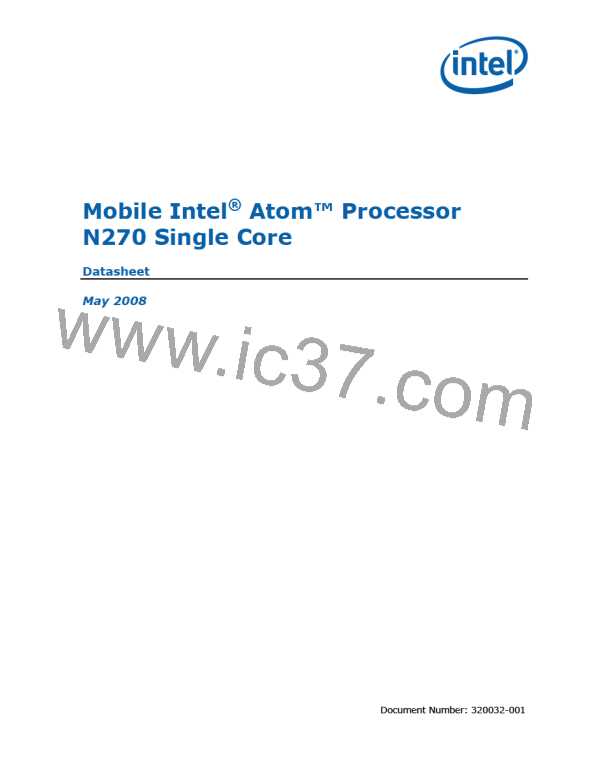Thermal Specifications and Design Considerations
limit and subsequently searches for the highest possible operating point. Please
ensure this feature is enabled and supported in the BIOS. Also with EMTTM
enabled, the operating system can request the processor to throttling to any
point between Intel Dynamic Acceleration frequency and Super LFM
frequency as long as these features are enabled in the BIOS and supported
by the processor.
The Intel Thermal Monitor automatic mode and Enhanced Multi Threaded
Thermal Monitoring must be enabled through BIOS for the processor to be
operating within specifications. Intel recommends Intel Thermal Monitor-1
and Intel Thermal Monitor-2 be enabled on the processors.
Intel Thermal Monitor-1, Intel Thermal Monitor-2, and EMTTM features are collectively
referred to as Adaptive Thermal Monitoring features.
Intel Thermal Monitor-1 and Intel Thermal Monitor-2 can co-exist within the
processor. If both Intel Thermal Monitor-1 and Intel Thermal Monitor-2 bits are
enabled in the auto-throttle MSR, Intel Thermal Monitor-2 will take precedence over
Intel Thermal Monitor-1. However, if Force Intel Thermal Monitor-1 over Intel Thermal
Monitor-2 is enabled in MSRs via BIOS and Intel Thermal Monitor-2 is not sufficient to
cool the processor below the maximum operating temperature, then Intel Thermal
Monitor-1 will also activate to help cool down the processor.
If a processor load based Enhanced Intel SpeedStep Technology transition (through
MSR write) is initiated when a Intel Thermal Monitor-2 period is active, there are two
possible results:
•
If the processor load based Enhanced Intel SpeedStep technology transition target
frequency is higher than the Intel Thermal Monitor-2 transition based target
frequency, the processor load-based transition will be deferred until the Intel
Thermal Monitor-2 event has been completed.
•
If the processor load-based Enhanced Intel SpeedStep technology transition target
frequency is lower than the Intel Thermal Monitor-2 transition based target
frequency, the processor will transition to the processor load-based Enhanced
Intel SpeedStep technology target frequency point.
The TCC may also be activated via on-demand mode. If bit 4 of the ACPI Intel
Thermal Monitor control register is written to a 1, the TCC will be activated
immediately independent of the processor temperature. When using on-demand mode
to activate the TCC, the duty cycle of the clock modulation is programmable via bits
3:1 of the same ACPI Intel Thermal Monitor control register. In automatic mode, the
duty cycle is fixed at 50% on, 50% off, however in on-demand mode, the duty cycle
can be programmed from 12.5% on/ 87.5% off, to 87.5% on/12.5% off in 12.5%
increments. On-demand mode may be used at the same time automatic mode is
enabled; however, if the system tries to enable the TCC via on-demand mode at the
same time automatic mode is enabled and a high temperature condition exists,
automatic mode will take precedence.
An external signal, PROCHOT# (processor hot) is asserted when the processor detects
that its temperature is above the thermal trip point. Bus snooping and interrupt
latching are also active while the TCC is active.
Besides the thermal sensor and thermal control circuit, the Intel Thermal Monitor also
includes one ACPI register, one performance counter register, three MSR, and one I/O
pin (PROCHOT#). All are available to monitor and control the state of the Intel
54
Datasheet

 INTEL [ INTEL ]
INTEL [ INTEL ]